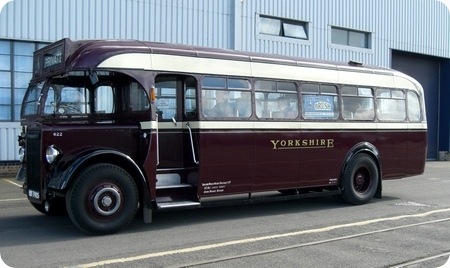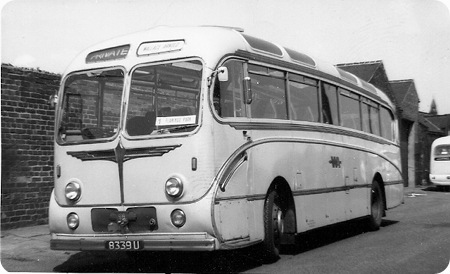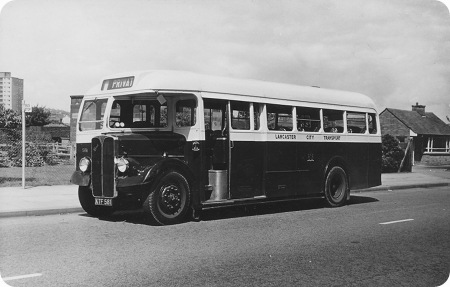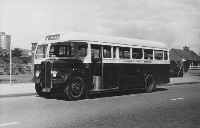Yorkshire Woollen District – Leyland Tiger PS1 – HD 7905 – 622
Yorkshire Woollen District
1948
Leyland Tiger PS1
Brush B34F
This great shot of a superb bus arrived above due to a comment made on another YWD vehicle on this site. The person who made the comment said he owned the only survivor of a batch of 75 Brush bodied Leyland Tiger PS1s. This I had to pursue, the bus is owned by Dr Gordon Brooke who as a schoolboy went to school on these Tigers when they were new and then in his student days he was a conductor on the actual bus above.
Many of the Tigers from the original batch of 75 were re-bodied as double deckers in 1954/5 but 622 carried on until 1960 when she was withdrawn from regular service. Instead of being sold on to a dealer which was normal, 622 was used for other things. First she was used as a driver trainer by Yorkshire Woollen District and secondly as a tow-wagon/gritter by the engineering dept with the rear end cut away and most of the seats removed. In 1969 622 was sold to W. Norths (PV) Limited, Sherburn-in-Elmet (dealer).
Gordon acquired 622 in 1988 but did not start restoration until 1990, he then spent the next 12 years restoring her to an immaculate original condition as can be seen from the photograph above. To maintain originality 622 has been painted in the dark maroon livery of Yorkshire Woollen District instead of the later Post Office red, this would have been the livery when she was delivered new.
The above photograph was taken early 2006 and 622 is seen outside the shed where she was originally built in 1948 at the Brush bodyworks Loughborough, Leicestershire.
From a photograph and information contributed by Dr G. Brooke
For much more detailed information regarding YWD Tigers click here.
“Looks like a beautiful restoration.”
Many people are aware of the 1960’s standard BET body with curved screens at either end and some are aware of the earlier version on underfloor chassis. This is the earliest version on half-cabs.
Various contractors would build to BET’s standard design – the final type mainly by Marshall, Weymann and Willowbrook. In addition to Brush, Roe and Weymann built to this design but Yorkshire Traction also had examples built by Roberts and Northern Coachbuilders.
Brush sold out their coach building side to Willowbrook in the early ’50s and shortly afterwards Willowbrook sold out to Duple. The bulk of the Brush empire remained to do much railway work – especially building locomotives.
David Oldfield
I just had to make comment on the above vehicle. Could it be the vehicle in which I passed my PSV test? It was May 1966, the driving instructor was Clifford Allott.
Colin Wilson
This looks a superb restoration.
How lovely it would be to hear this vehicle running. These Leyland PS1 and PD1 buses were blessed with a fascinatingly musical sound, especially in intermediate gears. How I remember Southdown’s examples crooning and murmuring, with gulps and sobs when going on to the over-run! Vehicles of this era were far more characterful than in the last 30 years.
Tony Evans
What a wonderful surprise it was to see that someone had restored an “Old Friend” I served my apprenticeship in the Savile Town Central works and passed my PSV on this vehicle. I also drove its converted (to double deck) sisters on the Birstall to Thornhill route on many busy Saturday duties. Where is it kept? as I would love to see it!!!!
Chris Bligh
I agree completely with Tony Evans about the fabulous music emanating from the PS1s and PD1s. I passed my PSV test on Samuel Ledgard’s PD1 JUM 378 – it had just arrived, warm, from a peak hour duplicate and was tuned to perfection for the difficult course around West Leeds – I sailed around fervently hoping to pass with the toughest Ministry examiner whose fearsome reputation put terror into the hearts of even experienced lorry drivers, many of whom failed for the slightest tinkle of even one gear. As we descended a steep hill in third gear an exasperated voice wailed through the rear cab window "There are four gears on this vehicle" – Fortunately I didn’t fall for that one as I would have failed on the spot. We returned to Armley Headquarters, still showing "Kingsley Drive" on the destination blind, and I was handed the famous pink slip and there began some of the happiest times of my long career. I was allocated a late duty the following day on the Leeds – Guiseley -Ilkley service, and another fine vehicle rolled up – LAE 12, a PD1 ex Bristol with the fascinating combination of an ECW body. Quality design and construction to the last nut and bolt, and every bit as well behaved and delightful as her all Leyland "half sister" who had done so well for me the previous day on the PSV test.
Chris Youhill
Those ECW-bodied "Bristol Omnibus" Leylands were rather smart hybrids. Do you have a photo of them in Samuel Ledgard service, Chris?
Chris Hebbron
Plenty of such photographs Chris H, which I’ll send to Peter by E mail and perhaps some may appear on here. We had three ex Bristol PD1s with ECW bodies, KHW 631, KHY 395 and LAE 12. We also had a further three with BBW bodies, not handsome but full of character and soundly constructed, KHW 243, KHW 622 and LAE 2.
Chris Youhill
The preserved YWD Tiger is resident at the South Yorkshire Transport Museum in Rotherham.
Chris Hough
My father was employed as a coach painter/signwriter by Yorkshire Woollen during the 1950s. He painted these Brush bodied PS1s among others. 586/91 608/12/22 were painted in reverse livery and went on loan to Hebble at Halifax. Dad said these were painted in overtime.
Philip Carlton
Super picture of the YWD PS1 which stirs memories in Bradford`s Chester Street Bus Station. Trouble is, most were rebodied as double deckers in an all over drab red livery, with what I think were the first examples (or very early) of MCW Orion lightweight bodies.
The Federation design of single deck body dates well before WW2, going back to c. 1932, being built by Brush, ECW, Weymann, Roe et al. There was even a double deck version with front upper deck window in 3 divisions, but seen in much smaller numbers. YWD had some with centre entrance, and Thames Valley seems to be in my memory, but EYMS were the principle users.
Chris Ys remarks about ECW bodied Leylands (and BBW!!) also reminded me that the Tilling Group purchased these in the early post war years as they could not get the required number of Bristols. Pity West Yorkshire didn’t`t get any, but this always seemed to be a "flagship" fleet.
John Whitaker
Many thank for your reply Regarding the PS1 622 I wonder if any of your members know what happened to 773 (UTF 930) a Leyland Demo that ended up at Y W D T. As I said in my previous email I worked at YWDT as an Auto Electrical Engineer in the 50/60s and recall with very fond memories 773 this must have been the best of 56 seater conductor operated buses. It was a extremely reliable vehicle you sent it out on Monday morning and forgot about it until someone remembered it may need cleaning or the oil changing it just kept running. The drivers would fight to get it on there duty as it was a pleasure to drive and had vacuum brakes which where very progressive, so the Conductors loved it as well!! The brakes had the Leyland R P adjuster mechanism which worked extremely well and the only attention it required between relines was a liner check every 2 weeks (the other thing that sticks in my mind was the very unusual “Exhaust Note” which sounded like a Ferrari!!!) If this Super bus still exists I would very much like to see it (Distance NO object)
Also I would like to hear from any one who worked for Y W D T around the 50/60s as this was one of the best times of my life!!!
Chris Bligh
Chris, 773 was renumbered 54 in 1967 and withdrawn in 1970 going to Norths of Sherburn in Elmet in 1971 and then sold for scrap February 1971. I remember the bus well as I started work at Saville Town in 1969 and I am still employed by YWDs successors Arriva although at Belle Isle. The bus was frequently on Chickenley area services and would romp up Wakefield Cutting in third and as you say a very popular bus with drivers. Another thing I remember that was unique with 773 was the continuous push bell strip the only one of its kind in the YWD Double decker fleet until the arrival of the 1965 Fleetlines.
As regards people in the Engineering department when I started.
Depot Engineer at Saville Town was Eddie Beaumont.
A charge hand called Eric Daniels.
Central works foreman was Bennett (Jack I think)
John Blackburn
I have had a great shot of the YWD Titan 773 (UTF 930) sent to me by Bob Gell so it will be posted in its own right mid February.
Peter
With regard to YWDT staff I was apprenticed to Jack Bennett (mid 50s) who became charge hand at Dewsbury Central works (Repair Shop). Eddie Beaumont was Charge hand on the “Daily Dock” section. Eric Daniels was a Ganger on the Daily Dock, I believe he had returned to “The Works” after National Service.
I also believe Jack Bennett went on the be a Fleet Engineer or T A at West Riding at Belle Isle. His farther was a driver at Dewsbury and also played the drums in the YWDT Band, he was always known as “Drummer Bennett”. Also thanks Peter I will look forward to seeing the Photo in Feb!!
Chris Bligh
22/02/11 – 06:30
In response to looking for old YWD employees. May dad (Fred Sharpe) was with the company for many years. Started at Saville Town, went to Bradford (Hebble depot), back to Heckmodwike (Beck Lane) before being retired.
Fond memories of the kids bus trip to the seaside on a convoy of single deckers from Long Causeway each year, with our little ‘Paddington Bear’ type tags dangling from duffle coats (always seems to rain on those days!)
Dad used to take ‘specials’ at weekends in Bradford, often fishing trips, where the ladies would go on to the coast while the blokes did the angling. Sometimes we would get to go with them for the ride.
Used to live in Chickenley, cost us three-ha’pence to town on the L/M bus when I was first allowed to travel alone, to Sunday School. Pretty sure my dad passed his PSV on the Tiger as well. He’s still around (Feb 2011), in Mirfield. I live in Doncaster now.
Gordon Sharpe
Rather curious what L/M stands for when you say "three-ha’pence to town on the L/M bus"
Peter
That was the service ‘number’ – several YWD services ran as letters.
The ‘A’ buses went from Batley/Birstall through Dewsbury town centre to Thornhill. Later they did multi routes on the ‘A’, making them A1, A2, A3 and A4, to denote which direction they went round Thornhill – I remember those because I caught them to my Grandma’s and needed to know where I had to get off, depending which route it was running. They are now the 281/282/283 I think.
‘B’ and ‘C’ went from Ossett to Fir Cottage, which went past my other Grandma’s. ‘G’ was Cleckheaton. I can’t remember any others just now.
Service "L and M" was Dewsbury to Chickenley, The L went clockwise, the M was anti-clockwise through Chickenley itself (I think it was that way round). They are possibly absorbed into what is now the 126/127 which goes through to Ossett, but it’s donkeys years since I last rode on the bus up that way.
They were converted to numbers by the time we moved to Bradford. My dad went to the Hebble depot (YWD stored a couple of vehicles there) to pick up a YWD bus for the 66 route to Sheffield, long before the current X33. I could catch the 66 all the way from Bradford (Chester Street bus station) to Frank Lane (Rectory Park) at Thornhill, then a walk up the hill to my grandma’s.
Gordon
23/02/11 – 06:30
Just to note Chris Bligh’s comment about the Yorkshire Bus Company Band. My dad had a copy of the LP they released ‘National Tour’, which I have since digitised and added a CD to the music library of the hospital radio station in Doncaster & Bassetlaw, which I’m involved with.
Back to the bus itself – I must take a trip to Rotherham, never knew such a gem was down there! Would be such a surprise to my dad if I could get a picture standing next to it…!
Gordon Sharpe
07/03/11 – 09:27
The YWD F route was Birkenshaw to Batley. Some of the services went on the new Healy by-pass. It was not really a popular duty since there was no-where at Birkenshaw to get a pot of tea. There was a cafe in Batley but I think this was only open early morning.
Jim Broughton
16/03/11 – 17:30
Chris Bligh regarding 773 it was the Bus that Never rang in, I remember drivers bringing sweets for Ivor the Garage man just to have it.
I was also at the workshops in 1963 as Apprentice Auto Electrician and worked under you and Robin before been banished to Beck Lane to work with Herbert Smithson.
With regard to Fred Sharp he was most well known for throwing the running board across the garage every day when you cancelled any buses.
"Happy Days"
Brian Taylor
29/03/11 – 07:24
WOW!!!! What a brilliant web site. Not only do i find the bus I passed my PSV test on, but an old (sorry for the word) colleague Brian !! How the devil are you???? I remember you well!! (Just to clear up a point , when I was at YWDT I was known as Robin Bligh, but after a few years people started calling me Chris and it stuck!!) I have many happy memories of YWDT and the people who worked with us. I’d love hear from you but this site is properly not the place! If you would like to contact me Peter at the Old Bus Photos website has my email address. I would be delighted!!
Chris Bligh
31/03/11 – 15:23
I think the garage man you referred to was Fred Smith at Beck Lane.Can you remember another garage man George Richardson who when you rang a bus in his stock comment was Let it develop.His sister Dorothy was a clippie at Beck Lane together they must have had over 50 years service with the company.
Philip Carlton
04/04/11 – 07:26
Yes Philip, I remember George very well!! He was a great guy, always a smile on his face and I believe he had spent some time in Iceland (the country not the shop) and had wonderful stores to tell about his time there. Also garage men at Beck Lane where Tommy Latham and Norman Pickles all great characters!!. Also remembered are Harry Snowden (Charge hand fitter) Walt Jennings (Foreman) Fred Smith (SS Fitter) Gerald Kay (SS Fitter) and of course Mrs Rocket canteen lady (I use the word lady lightly).
I vividly remember Tommy Latham going out to Bradford to tow in a PD” Decker, with Gerald Kay with the old Tow Truck (Ridged Bar Tow) and arriving back in the depot on his own trailing the tow pole and wondering what had happened to Gerald. He was sent back to find him and did find him in the middle of Heckmondwike blocking all the traffic!!. It took him many (Long) years for him to “Live that one down” .
Chris Bligh
02/07/11 – 07:01
I learnt to drive in this bus in 1965, Clifford Allott was the driving instructor Tom Batty tested and passed me. They are great days to look back on I played football and cricket for the YWD for a few years 1960/1970 finally left the company in 1980. The photos are fine to look back on but they also bring back memories of cold winter mornings sat in cabs with newspaper around the windows to keep the draught out and most of them were an handful to drive I’m thinking mainly of the old Guys and the Salmon cans in particular. But it was an experience I wouldn’t have missed for the world.
John Ward
04/10/20 – 07:21
Great photo, my wife’s grandfather built this vehicle at brush. We have seen it a few times at bus days out.
Mark Dwyer




